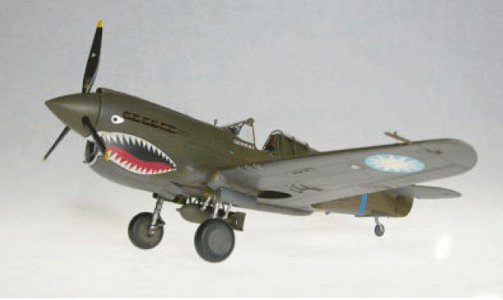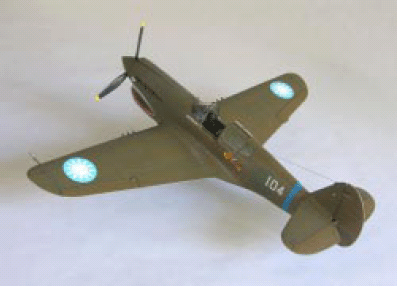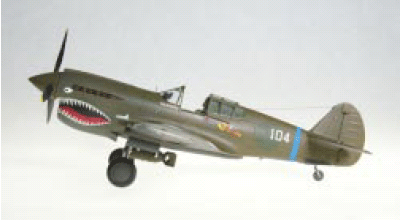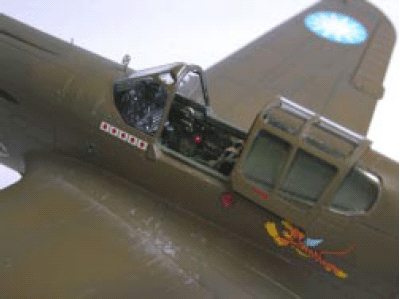
          
|
Hasegawa's P-40E and CMK's Interior DetailsBy Milton Bell, Originally published February 2006
One of the first 1/48 models I built when I got back into the hobby was Otaki's P-40. I used the kit decals and did the Aleutian Tiger. Not a bad kit but those thousands of recessed rivets were distracting, and I never was able to get the engine installed with the access panels closed. But I built it and had fun. After all, it�s a hobby and that�s what it�s all about - having fun. I hadn�t built a P-40E since then, although I had done the AMtech�s "F" type and once started the "E" variant that Revell released years ago. So, why this model? When I was a small boy the Flying Tigers were our heroes, and we all knew they flew P-40s. Who doesn�t recognize the airplane with the sharkmouth? I decided to do Ed Rector�s No. 104, one of the first P-40Es sent to bolster the ranks of P-40B/Cs in Chennault�s band of volunteers. Hasegawa�s kit is probably the best P-40E out in the 1/48th scale market. Its design immediately says that this is just one of a series. Indeed, since its release, Hasegawa has brought out the P-40N and I expect this year to see a P-40K. I�ve no doubt that the "F" and "M" variants, and maybe even the "L", will eventually be added to the Hasegawa line. Construction As usual, I began with the cockpit. While Hasegawa�s cockpit is well done and can be very convincing, I decided to use the CMK resin sidewalls. I had originally wanted to use all of the CMK resin, but I actually liked the Hasegawa floor better. I also liked the kit�s aft bulkhead better, since it had the stand-alone mounts for the seat. So my finished cockpit has the CMK�s instrument panel, sidewalls, and resin seat mounted on the kit-supplied floor with kit bulkhead, featuring a modified kit gun sight! And of course the ring and bead sights are PE. Getting all this to fit was actually pretty easy, and I had to trim only a small bit from the sidewalls to get them to adapt to the plastic parts. One of the reasons I used the CMK parts was that the PE fret had colored belts and a good looking instrument panel. I had used the Eduard colored PE parts many times and like them a lot. I wanted to try and compare the CMK parts. There are several PE parts that must be glued onto the sidewalls. For small parts, especially PE, I prefer white glue since it�s much more forgiving and is easier to clean up.
The kit is engineered so that the tail sections are separate pieces as is the area immediately aft of the cockpit. The area just aft of the cockpit, the "turtle" is a separate piece so doing the "N" just requires a different part. CMK provides a resin "turtle", and I decided to use it. I did not follow the instructions regarding the tail parts. Instead, I attached each tail half to its matching fuselage half to ensure the panel lines matched. The only filler that was needed was on the wing guns and the fuselage bottom. The rest of the model is pretty much an easy build. Just remember to look closely at the instructions so you don�t get the wing sealed up and discover you left out the wheel wells. Hey, it can happen! I decided not to use the underwing gun camera since I couldn�t confirm that Rector�s aircraft had it. If I find I was wrong, I�ll add it later. All parts were given a base coat of dull dark green (in this case Medium Green 42) since that�s what I believe most of these airplanes had at this time. I used Polly Scale paints throughout. When the paint dried, I gave it all a good coat of future and then applied a dark brown wash, in this case burnt umber dissolved in lighter fluid (naptha). I prefer lighter fluid because it evaporates quickly. I generally leave off all small details (exhaust stubs, landing gear, weapons, tanks, etc.) until the very last. I hate to break off a part and then lose it! Painting and Decals Rector�s aircraft had been drawn from stocks intended for the British so they had the dark green and dark earth over light gray/ blue that Curtiss thought matched the British camouflage colors. These new P-40Es were finished in Olive Drab (OD) on the upper surfaces and Neutral Gray (NG) below. The few pictures that exist of these new arrivals bear out the single upper color so here I parted company with Hasegawa�s painting instructions which show the two-color upper surface camouflage. I used two shades of OD, a faded OD 22 for the base coat and a darker USAAF OD for the areas more likely to get that extra dose of grease and oil. The lighter shade was used for the fabric covered control surfaces. Since these aircraft were off-loaded at Accra in West Africa and flown cross-country to China, it�s doubtful that they arrived in pristine condition. Weathering was a must. I used a silver pencil to show chipped paint on hatches, and wing-walk areas. Then two coats of Future were misted on and when it was dry the decals were added. When the Flying Tigers� P-40s arrived in China they became a part of the Chinese Air Force. The fuselage star and circle insignias were painted out, as were the underside codes and all serial numbers. Chinese stars were in fact large preprinted "decals", and were applied over the US insignia on the wings. I used kit decals as well as the Chinese markings from Sky Model�s P-40 sheet. I also have the Tally Ho sheet of P-40 stencils, but most photos from the period don�t show any stencils at all. So the only ones I used were on the landing gear struts. Exhaust stubs were painted Alclad steel and finished with Mig Rust.
And speaking of landing gear, I primed all the parts with Mr. Surfacer and then gave them a coat of Alclad Duraluminum. The bomb sway-braces were treated the same way. When the landing gear struts were dry, I added brake lines made from black coated wire intended for model car distributors. When all was totally dry, I applied a wash of burnt umber to the whole model and then wiped it down with a soft cloth and a little naptha. Then a final coat of Polly Scale flat finished the model. Here�s a simple tip you might want to try for quick weathering. I use Future for a barrier before wash-weathering. If you add a scant drop (and I mean scant) of black India ink to the Future you will find it gives better definition especially on natural metal parts. As the future dries the ink migrates to the corners and crevices. Looks great on P-47 prop bosses.
Bombs and Tanks Since my model was to be of an aircraft that participated in the raids at the Salween River Gorge, I used the kit bomb. Historically, the 250 kg bombs carried by AVG were of Russian origin, and each had only one mounting lug. A strap was added to hold the second lug. Accordingly, I added a strap to the kit bomb, but I have no idea what the original looks like. The sway braces in the kit are not identical, so the modeler has to be sure to match them to the load. Conclusion Hasegawa has a very nice product in the P-40E. I already have the "N" version waiting in the closet, and it may start calling my name soon. The "E" is a good kit, and it is not too challenging, even for a beginner. I recommend it. And for the most part I recommend the CMK detail set. Just be careful of the resin "turtle" and be sure the quarter window panels will fit. You may have to deepen the recessed areas on the resin part. The prepainted PE parts worked just fine. For more information on the Flying Tigers, get the Osprey book "Aircraft of the Aces #41, American Volunteer Group Colours and Markings" by Terrill Clements. IMO it�s the best single reference on the AVG you can find.
|
� Copyright 2010, Austin Scale Modelers Society (ASMS)




